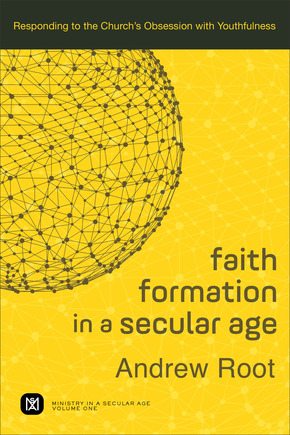For many churches the youth ministry is a very important part of the life of the congregation. If the youth ministry is going well, the church is an attractive place to be. There is an energy, a vibrancy, a liveliness, about what’s going on in that church. On the other hand, when a church’s youth ministry isn’t seen this way, suggestions about what the church is going to do about the “young people” are vocalised.
In his latest work, Faith Formation in a Secular Age: Responding to the Church’s Obsession with Youthfulness Andrew Root shows how the church has taken up the mantle of wider society in its idolisation of youth culture. Furthermore, the church uses models and pathways to form faith that lack the variety and emphasis needed for Christians to deal with the secular age.
Root’s book is split into two parts. The first deals with the historical context of youth culture in society at large, showing how it has influenced the church. This is mostly framed through the work of Charles Taylor and his monumental book, A Secular Age. The second part deals with faith and faith formation—how this is currently thought of in churches and youth ministry. He explores whether a deeper understanding of faith, shaped by Jesus’s humility and cross-formed service (Philippians 2) can influence faith formation going forward. The framework for this section is mainly through the thinking and commentary of Michael Gorman.

Faith Formation in a Secular Age
Andrew Root
PART I
Part one makes a lot of sense. It develops a strong argument that western culture has accepted authenticity and youthfulness as inextricably bound. That is, since the mid-twentieth century marketeers, advertisers, the sexual revolution, and the bohemian and hippie movement, have valued youthfulness as a primary goal and aspiration for individuals and society.
As the increase of secularisation within the West has risen sharply in the post-war era, youthfulness has been equated with authenticity. Root shows how the impact of seeking the cool, the hip, and the popular, has led to a path where youthfulness is highly desirable. And it is this youthfulness that is thought of as authentic, stripped of the pretence and responsibility that comes with older age:
It is little wonder, then, that in the last fifty years the churches that have sought to be most like youth groups have fared the best, for they’re seen as authentic…When youthfulness becomes the measure of authenticity, faith formation is ever difficult, and not only because we fight against the disease of MTD (Moralistic Therapeutic Deism), but more broadly because the conditions we live in minimize divine action…When we link faith to the authenticity of youthfulness, we make youthfulness itself faith’s measure. We support and affirm that where youthfulness goes, so too goes authenticity. (p13)
This has resulted with churches increasingly viewing youth ministry as a “saviour” for their church. While the church youth movement has historically been there, it is really only in the last fifty years that this area of the church has risen to the level it is today. There was actually a time when churches didn’t have a youth pastor and where the work toward the young people was driven by a group of volunteers. The striving after a pastoral staff position specifically for youth ministry is something new, relatively speaking.
A by-product of this is churches increasing their value for and commitment to keeping young people in the church. This increase in attention has also created youth ministry and youth focussed para-church organisations that seek to hold a young person in the orbit of faith. This kind of thinking hopes to see more kids, and particularly kids of church families, stay in church life instead of walking away and becoming one of the ‘Nones’ who are now self-identifying in surveys and census data. As Root remarks, “Even today, study after study in youth ministry seems to define faith primarily through institutional participation.” (p30)
The connections that Root makes between the rise of youthfulness in society, the chasing after authenticity, and the downplaying of divine action (or transcendence, as Root puts it) is compelling.
What is helpful in Part I is the historical setting and cultural understanding from the 1950s until today. The connections that Root makes between the rise of youthfulness in society, the chasing after authenticity, and the downplaying of divine action (or transcendence, as Root puts it) is compelling.
This historical overview helps to shed light on the current day value on youth ministry and gives even more evidence toward the concept of “Moralistic Therapeutic Deism” (MTD). God wants me to be a good person (Moralistic), God is a being who should help me feel good (Therapeutic), and God is a concept to decorate our lives with but isn’t an agent who really does anything (Deism). With MTD running through the veins of most churches and youth ministries today it is little wonder faith formation is pushed toward institutional membership and attendance rather than recognising that God is actually at work.
…our conception of faith formation has too often followed this expressive (even instrumental) individualism. Too often, in both evangelical and mainline churches, faith formation has been seen as the process of raising consciousness. And while in some ways this seems to honor the age of authenticity; it also tends to turn faith into a cultural reality that loses purview of divine action. (p57)
Coming out of Part I questions are raised as to how can the church deal with this situation. How can the church bring back a sense of the transcendence of God? How can youth ministries improve their ministries in order to counteract not only MTD but also the rise of the youthfulness idol? Are there things we can do as the church in order to help faith be formed in this age?
PART II
This part of the book delves into the way we think about faith formation. It is a deep dive into how the secular age is impacting our view of faith formation and a critique on current programs and discipleship pathways. This section is not always easy to understand.
Leaving the historical context behind, Root brings some broad-brush solutions in forming faith in a secular age. Therefore,
…something more robust and theological than simply the affirmation of religious or spiritual experience is needed. Rather, for such experiences to be anything more than hiccups of the individual and her journey of authenticity, transcendence or divine action must be reimagined. (p116)
This is what Root seeks to do for the rest of the book.
Defining faith becomes important, and so a whole chapter is committed to this. In the end, faith is defined not only as assenting to beliefs in Jesus but also an understanding that action, in the form of cross-serving, cross-bearing loyalty, is important. Root, quoting Michael Gorman, says,
Faith then, for us, is a complex human experience, and Paul preserves this complexity while giving it a unique twist. While affirming its character as trust and conviction, Paul connects faith to the experience of Jesus as God’s faithful Son. Faith is more than trust; it is also fidelity, or loyalty. (p120)
As this chapter continues it becomes unclear whether “faith” is the formation of a Christian faith or the commitment to Jesus through faith alone. Another couple of quotes will highlight my confusion.
Faith for Paul is not sure commitment but the experience of being found in Christ, of being found in union with him in and through the negation of the cross. Faith, for Paul, as for Abraham, is the bravery to walk into negation for the sake of encounter with divine action; it is to give loyalty to the reality of ministry. (p129)
And,
Faith, then, for Paul is the transcendent encounter with the person of Jesus through negation, which forges a ministry of union that can turn death into life. This faith calls us to participate in the life and saving activity of God by becoming ministers. (p130)
As you can see, faith is commitment and experience and union with Christ, which also includes the actions undertaken for the sake of mission and ministry. While on one level it is understandable to affirm this, it is, I believe, a category mistake to mesh the two. It requires faith to believe in Jesus, and it requires faith to be involved in the action of God through mission and ministry. Yet, it is the faith that assents to Jesus which is saving faith. The other type of faith is that of response to saving faith. I think this is important to clarify, particularly in this age.
By the end of the book we end up with some answers to how faith formation can be achieved in such an age. The final chapter is dedicated to giving five responses in how to form faith; these are:
- be grateful,
- discover your gifts for ministry and mission,
- rest; and understand its importance in this age,
- be a kind and godly person,
- and share and listen to personal stories of ministry.
At the end of this work I find myself left unsatisfied with its conclusions. It is book of two halves, one of which I found interesting because of its history and cultural analysis. The second though, makes hard work of trying to explain that people are to have faith, serve in faith, proclaim faith, and expect it not to be accepted as truth in this secular age.















